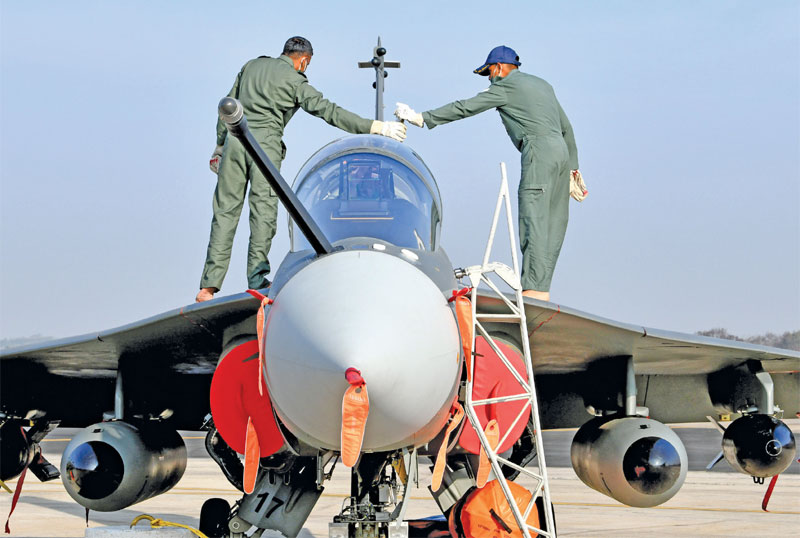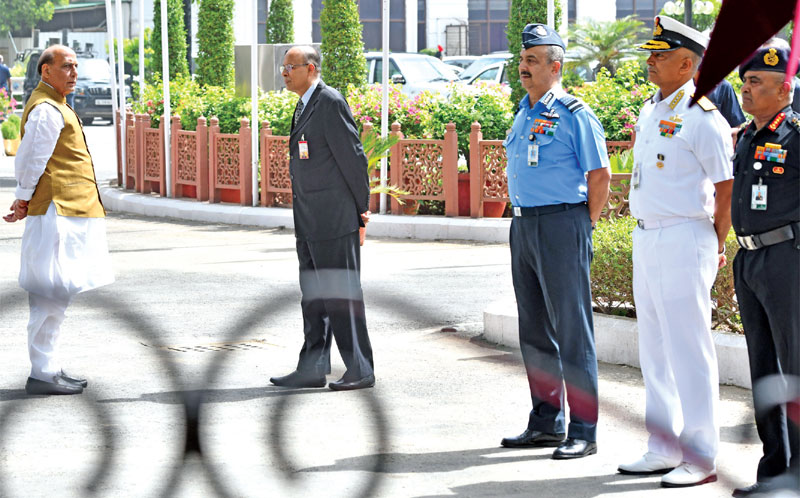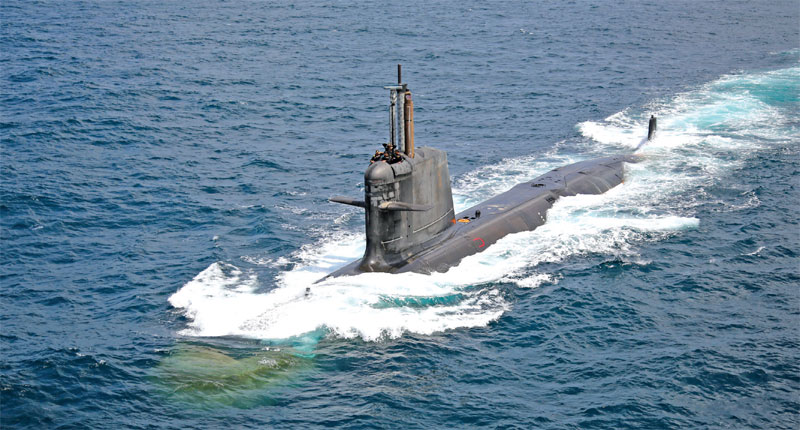Limited capital outlay, fanciful RFPs and tedious policies are retarding the acquisition process
 Gp Capt. AK Sachdev (retd)
Gp Capt. AK Sachdev (retd)
India’s accomplishments in space, (surface to air, cruise, intercontinental ballistic) missiles, nuclear submarines, aircraft design, main battle tanks and some other areas are noteworthy but, paradoxically, it is currently the leading arms importer globally. As far as equipment for its own military is concerned, India’s manufacturing capability in the defence industrial arena is largely restricted to modest levels of technology—lagging behind the leading edge of technology in many critical cases; more than 50 per cent of its requirement comes from imports.
Given its long history of importing a full spectrum of military hardware for the last 75 years, one would have expected that practices for a smooth import process would have been refined and enshrined as defence procurement/ acquisition procedures and honed into perfect practices. Regrettably, consummation of acquisition deals continues to be beset by inordinate and mystifying delays and is occasionally thwarted after years of prolonged procrastination. This article looks at the malaise and possible remedies; random illustrative cases are discussed as there is inadequate space for a comprehensive analysis of all delays.
Defence Acquisition Procedure
The handbook guiding Indian military acquisition is the Defence Acquisition Procedure (DAP-2020), issued under the signature of the defence minister on 30 September 2020 and last updated on 13 April 2022. It was earlier known as Defence Procurement Procedure (DPP) and was first promulgated in 2002 by the Defence Acquisition Wing (DAW) under the department of defence.
Since then, it has been revised eight times. Manohar Parrikar, the then defence minister, personally involved himself with the 2016 version which, over four years from its promulgation, garnered 47 amendments, forcing DAW to undertake another massive review exercise. The result was the draft DAP 2020 which replaced ‘procurement’ with ‘acquisition’, possibly because ‘procurement’ relates more to purchasing equipment off the shelf while ‘acquisition’ is the process of identifying and describing needs, capabilities, and requirements, as well as determining the best method for meeting those requirements. Thus, procurement is a subset of acquisition.

Despite constant calls from industry and user services to simplify the procedure on paper and enhance the ease of doing business, the handbook has become more and more complex and long-winded with each revision, and the current version is close to seven hundred pages. The government’s intent may have been to proffer a comprehensive document but bureaucratic delays in the acquisition process have proved to be directly proportional to the voluminosity of the document.
Chapter V of DAP-2020 deals with Fast Track Procedure (FTP) whose aim is defined as ‘to ensure expeditious procurement for urgent operational requirements of the Armed Forces, foreseen as imminent during war as well as peace time and for situations in which crisis emerges without prior warning. FTP may also be applied for cases where time lines of the normal prescribed procedure in procuring of operationally critical equipment is seen to be adversely impacting the capability and operational preparedness of the Armed Forces.’
However, the interpretation of what are ‘urgent operational requirements’ remains subjective; as an illustration, the DAW appears to attach no urgency to what the military sees as definitely fitting that definition e.g., the combat squadron strength of the IAF, now hovering at 31/32 against a sanctioned figure of 42.

The IAF’s Angst
With an eye on the foreseeable attrition and shift to obsolescence of its then holding, the Indian Air Force (IAF) had initiated a case for more Mirage 2000s as far back as 1990. After the usual bureaucratic delays, the Defence Acquisition Council (DAC) scuttled the project in 2003.
A Request for Information (RFI) was floated in 2004 for purchase of 126 Medium Multi-Role Combat Aircraft (MMRCA) possessing 4.5 generation capabilities with the stated intent of inducting the first aircraft by 2010 (the reader may note that six years was the projected time from RFI to induction!). The IAF reached its decision on the comparative merits of six candidates, but bureaucratic delays and indecisive governments delayed the process inordinately. The Rafale was short listed finally in 2012 and in March 2014, HAL and Dassault signed an agreement for licensed production of the Rafale in India.
In April 2015, during an official visit to France, Modi announced (in a move which surprised the IAF and the MoD) that India would acquire 36 Rafales from France in a fly away condition. A couple of months later, and more than a decade after the RFI was floated, the defence minister informed the Parliament that the 126 MMRCA quest was over. Meanwhile, the gap foreseen in the 1990s had widened considerably and continues to widen even as we read this, despite the induction of 36 Rafales.
If the 42-squadron figure is to be achieved even by end-2040, another 450 combat aircraft need to be inducted by then in view of expected attrition and obsolescence. Two hundred Tejas are expected to be the major constituent (40 Mark 1 already ordered, 83 Mark 1/1A in the pipeline, and another hundred odd Mark 2s in the hazy future), while another hundred are expected to be fifth generation Advanced Medium Combat Aircraft (AMCA) to be produced indigenously.
The current versions of Tejas are yet to be proved as operational aircraft while the future ones are veiled by uncertainty. The AMCA project does not inspire much confidence as the Tejas has taken more than three decades to fly and is yet not an operationalised fighter. Thirty three aircraft are planned to be procured (21 MiG-29s and 12 Su-30MKIs) but still there will be a gap in the 450 aircraft. While the half-baked Tejas and the under development AMCA are nebulous projects, there is an urgent need to have 100 to 150 fighters at the earliest. The 114 MRFA’s Request for Information (RFI) was released in April 2018 by MoD for acquisition of 110 aircraft (the figure was later revised to 114). The RFI was 72 pages long, prescribed six roles for the multi role aircraft and was silent on whether it was a single engine one or a twin engine one. Disappointingly, four years and three months have passed since then; there is some news about the project being shifted from the strategic partnership model to the Buy Global, Make in India one but the urgency with which 36 Rafales were ordered suddenly is not visible now nor the need to invoke Fast Track provisions of DAP-2020.
Other delayed IAF projects include follow-on order for C17 Globemaster, upgrade of Super Su-30 MKI, Phalcon AEW&CS, Kamov Ka-226T helicopters to replace the dying Chetaks/ Cheetahs, and flight refuelling aircraft.
Naval Project-75I
Project 75 (India) or 75I submarine project for diesel-electric submarines for Indian Navy is another typical illustration of debilitating delays. The project germinated from a 1997 ministry of defence (MoD) plan to acquire 24 submarines. An RFI was issued in 2008 and after several flip flops, another RFI emerged in 2017 (partly due to the introduction of Strategic Partnership model in DPP-2016). The RFP took four more years to be issued and the process continues at a leisurely pace with the end nowhere in sight.
Other delayed naval projects include sonar systems, midget submarines, survey vessels, naval utility helicopters/Ka-31, upgrade of weapons and sensor suite of the Delhi and Talwar class ships, follow-on of Talwar class frigates, follow-on order for P-8Is, and Landing Platform Helicopter (LPH).

Light Howitzer for Army
The army first expressed interest in the acquisition of 145 BAE M777 Ultra Light Howitzer guns from the US in 2007. The DAC gave an Acceptance of Necessity (AoN) in 2012 and another one in 2014 but soon thereafter, a new selection process was started, this time under ‘Make In India’ programme; another AoN was issued in 2015. The final contract came in 2016, a decade after the army first expressed its need and more than three decades after the sordid saga of Bofors gun induction.
Other delayed programmes include Kamov Ka-226T Air Defence Guns to replace L70 and Zu 23 mm guns, follow-on order for SSK 155mm/52 calibre mounted gun system and Apache helicopters.
Concluding Remarks
According to reports, only eight to 10 per cent of proposed defence projects have fructified within the time periods stipulated in DPP/ DAP. The Comptroller and Auditor General (CAG) has continually noted in its reports that delays in acquisition are essentially due to the complex and multi-level process; it has specifically stated that the current system is unlikely to support the operational preparedness of the military and that MoD needs to undertake structural reforms of the acquisition process.
DAP-2020 prescribes (at Page 164) the proposed time line for procurement and indicates more than two years as the time period from Acceptance of Necessity (AoN) till the signing of a contract; the process has 11 to 17 steps depending on the category of acquisition. In real life, the process takes more than five years even for small pieces of equipment or apparel while big ticket acquisitions, as illustrated by the MMRCA above, take much longer.
The simple question that comes to one’s mind is: Why? The answer to that lies in the absence of accountability to adhere to the time lines prescribed which, in effect, serve as notional guidelines on paper, adherence to which no entity is held accountable. There is a ‘Monitoring Mechanism’ prescribed in DAP-2020 but it seems to be entirely ineffective and inconsequential; indeed, in many cases the AoN, which usually has a life of 104 weeks, lapses before moving onto the next step in the acquisition ladder. It is unlikely that any bureaucrat would be held responsible and subjected to punitive action for a delay as the letter of the DAP would permit myriad loopholes as alibis for delays. Fixing this malady is the first step towards reducing and hopefully eliminating inordinate delays in acquisition. For each step in the ladder, a single-point accountability needs to be defined and lapsing entities disciplined. The first step in that direction could be to define time periods for clearing project files at each MoD and single service HQ desk/ office involved in the process.
It would be unfair to attribute the delays entirely to bureaucratic bungling. In 2007, CAG had recommended that the Air Staff Qualitative Requirements (ASQR) be stated in terms of functional parameters which are measurable. Subsequent CAG reports have pointed out that IAF has been producing exhaustive, narrowly defined ASQRs describing technical details thus leading to limited competition at the RFP stage. Indeed, in the case of MMRCA, RFP bids not meeting the ASQRs had also to be technically qualified during the process of selection to get a reasonable number of competitors.
Notwithstanding the practicality or otherwise of the Fast Track procedure prescribed in DAP-2020, the government has demonstrated its nimbleness in compressing all the long-winded steps in the acquisition process into weeks if not days by executing the 36-Rafale deal with utmost haste and secrecy. One wishes that agility akin to that displayed in procuring 36 Rafales is somehow transposed into DAP-2020.
Another portent of acquisition delays is the overbearing push for ‘Make in India’ and ‘Aatmanirbhar’ ideas. Despite Modi’s and the government’s visible push behind both, the actual contribution of either of these, beyond sloganeering, has been negligible as far as Indian military is concerned. A few months ago, the CDS made a statement that all future combat aircraft we induct would be indigenous. The ridicule his statement invited brought the realization that an indigenous fighter of the leading-edge variety would take India a long, long time to produce, maybe two decades plus. Our Kaveri aero-engine is unlikely to be strapped on to our aircraft in the near future despite two decades of massive investments in Gas Turbine Research Establishment (GTRE).
The point being belaboured here is that the more we harp on indigenous equipment, the more we are inviting delays (besides the fact that in many cases we would have to lower SQR expectations). There is, thus, a need to weigh the indigenous agenda with critical operational military requirements. It is also pertinent to note that no major or significant project has taken off under Make in India/ Aatmanirbhar constructs since they germinated.
Some of the delays that bureaucratic machinations strive for probably owe their origin to budgetary constraints. Defence budget for modernisation received Rs 63,000 crores less than what was demanded for financial year 2022-23. It is apparent that AoNs will be delayed to tailor to the allocated capital budget outlay. In this context, one is reminded of Chief of Army Staff General Malik’s statement of ‘we will fight with what we have.’ The resultant compromises made to national security are evidently acceptable to the government after weighing them against fiscal compulsions. One hopes that the wisdom of these decisions is not invalidated through an ignominious military engagement with either or both of our inimical neighbours.

